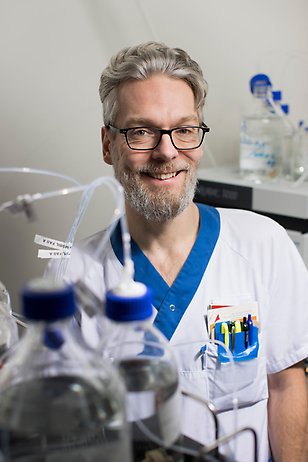Translational Neurology
The group mainly works with the diseases multiple sclerosis, stroke and epilepsy. We study disease mechanisms, biomarkers, epidemiology, and the effects of advanced treatments. The team uses a broad range of methods including immunological techniques, mass spectrometry of small molecules, protein analyses, medical imaging, register-studies and conducts clinical trials. There is a special focus on research into autologous blood stem cell transplantation as a treatment for multiple sclerosis.

Joachim Burman.
Description of our research
We are mainly working along two research lines. One is the development of new methods for diagnosis and prognosis of neurological diseases. The second is to investigate autologous hematopoietic stem cell transplantation as a treatment for multiple sclerosis.
Multiple sclerosis
Multiple sclerosis (MS) is a debilitating disease affecting mainly young individuals, with a peak incidence around 30 years of age. In Sweden 20,000 persons suffer from MS, and worldwide an estimated 2.5 million. Untreated, it leads to severe disability and premature death. It is considered to be an inflammatory and autoimmune disease of the central nervous system. The cause of MS is unknown, but epidemiologic and genetic studies indicate that MS is triggered in genetically susceptible individuals following exposure to environmental factors. This eventually leads to loss of tolerance and activation of myelin-specific T cells, myelin destruction, secondary axonal damage and neuronal loss. The course of MS is heterogeneous and involves an early, predominantly inflammatory disease phase of relapsing-remitting MS (RRMS). After a variable period of time, RRMS evolves into a progressively degenerative stage (secondary progressive MS, SPMS) with neurodegeneration, brain atrophy and accumulation of disability.
Autologous hematopoietic stem cell transplantation
Autologous hematopoietic stem cell transplantation (AHSCT) has been used for malignant disease since the 1950s and since then more than one million transplants have been performed world-wide. In 1990, Edward Donnall Thomas was awarded the Nobel Prize in Physiology or Medicine for the development of HSCT as a treatment for leukemia. This potentially curative treatment was introduced in Scandinavia as a treatment for MS by our group in 2004, and is considered the most powerful therapeutic intervention for MS. In difference to conventional DMD treatment, it is a one-time procedure that can arrest and sometimes reverse disability. Although the procedure is expensive it is superior to conventional therapy in terms of efficacy and cost-effectiveness. After pioneering work by us and others, it was recommended for patients with active MS by the Swedish Board of Health and Welfare in 2016, but nevertheless it is often viewed as a last resort and currently less than 1% of patients with MS is offered this treatment.
Publications
Evoked potentials after autologous hematopoietic stem cell transplantation for multiple sclerosis
Part of Multiple Sclerosis and Related Disorders, 2024
- DOI for Evoked potentials after autologous hematopoietic stem cell transplantation for multiple sclerosis
- Download full text (pdf) of Evoked potentials after autologous hematopoietic stem cell transplantation for multiple sclerosis
Part of Multiple Sclerosis and Related Disorders, 2024
- DOI for Cerebrospinal fluid mtDNA concentrations are increased in multiple sclerosis and were normalized after intervention with autologous hematopoietic stem cell transplantation
- Download full text (pdf) of Cerebrospinal fluid mtDNA concentrations are increased in multiple sclerosis and were normalized after intervention with autologous hematopoietic stem cell transplantation
Part of Journal of Neurology, Neurosurgery and Psychiatry, p. 125-133, 2024
- DOI for Haematopoietic stem cell transplantation for treatment of relapsing-remitting multiple sclerosis in Sweden: an observational cohort study
- Download full text (pdf) of Haematopoietic stem cell transplantation for treatment of relapsing-remitting multiple sclerosis in Sweden: an observational cohort study
Part of PLOS ONE, 2024
- DOI for Experiences of being treated with autologous haematopoietic stem cell transplantation for aggressive multiple sclerosis: A qualitative interview study
- Download full text (pdf) of Experiences of being treated with autologous haematopoietic stem cell transplantation for aggressive multiple sclerosis: A qualitative interview study
Disease phenotype prediction in multiple sclerosis
Part of iScience, 2023
- DOI for Disease phenotype prediction in multiple sclerosis
- Download full text (pdf) of Disease phenotype prediction in multiple sclerosis
Part of JAMA Neurology, p. 702-713, 2023
Part of Acta Neurologica Scandinavica, 2023
- DOI for Antibody-Positive Autoimmune Encephalitis and Paraneoplastic Neurological Syndrome: Epidemiology and Outcome of Neuronal Antibody Testing in Sweden
- Download full text (pdf) of Antibody-Positive Autoimmune Encephalitis and Paraneoplastic Neurological Syndrome: Epidemiology and Outcome of Neuronal Antibody Testing in Sweden
Plasma neurofilament light chain is elevated after transcatheter aortic valve implantation
Part of Cardiology, p. 478-483, 2023
- DOI for Plasma neurofilament light chain is elevated after transcatheter aortic valve implantation
- Download full text (pdf) of Plasma neurofilament light chain is elevated after transcatheter aortic valve implantation
Part of Lipids in Health and Disease, 2023
- DOI for Autologous hematopoietic stem cell transplantation significantly alters circulating ceramides in peripheral blood of relapsing-remitting multiple sclerosis patients
- Download full text (pdf) of Autologous hematopoietic stem cell transplantation significantly alters circulating ceramides in peripheral blood of relapsing-remitting multiple sclerosis patients
Part of PLOS ONE, 2023
- DOI for Anti-Müllerian hormone and pregnancy after autologous hematopoietic stem cell transplantation for multiple sclerosis
- Download full text (pdf) of Anti-Müllerian hormone and pregnancy after autologous hematopoietic stem cell transplantation for multiple sclerosis

